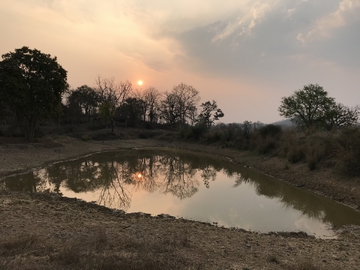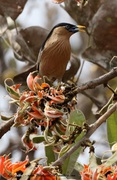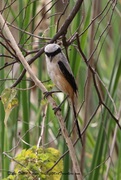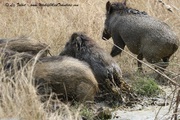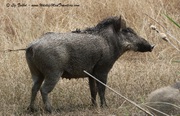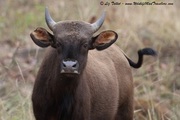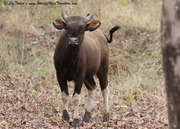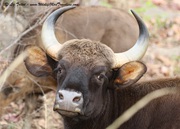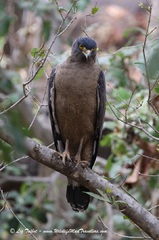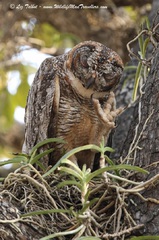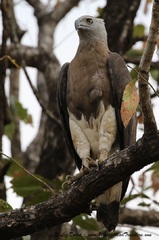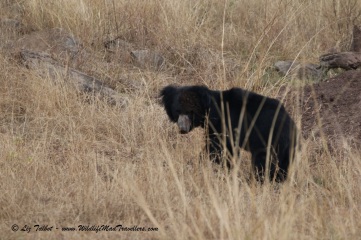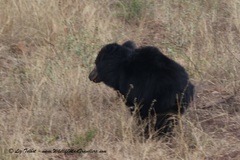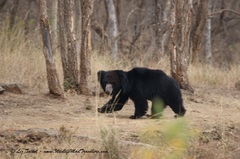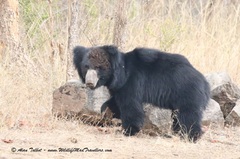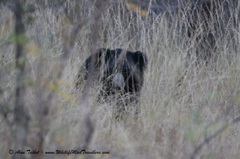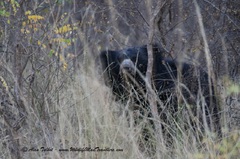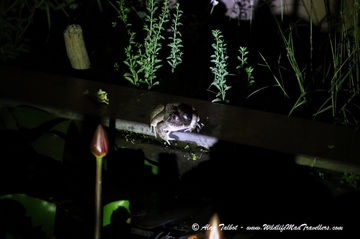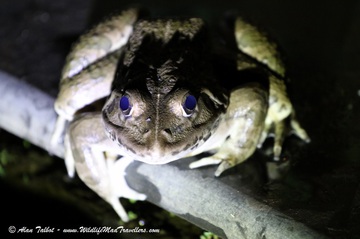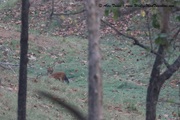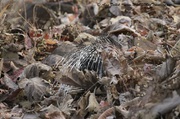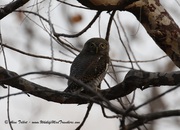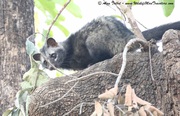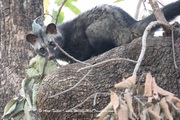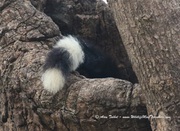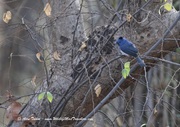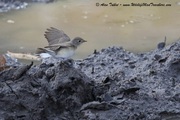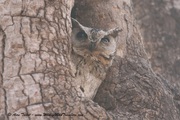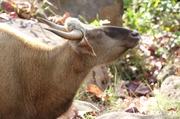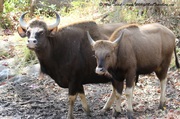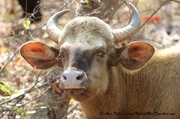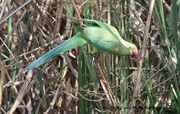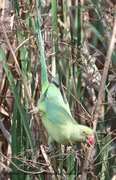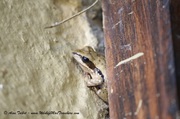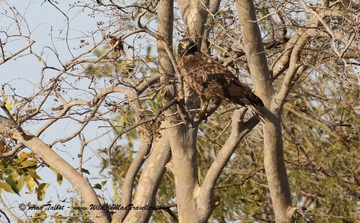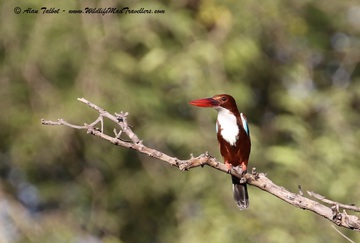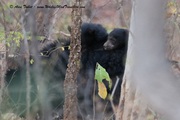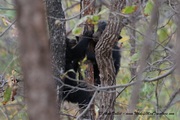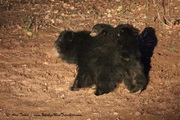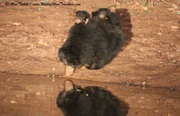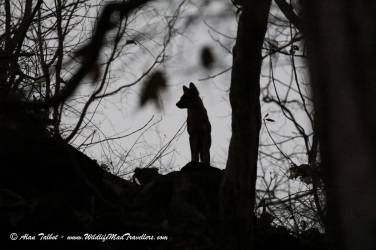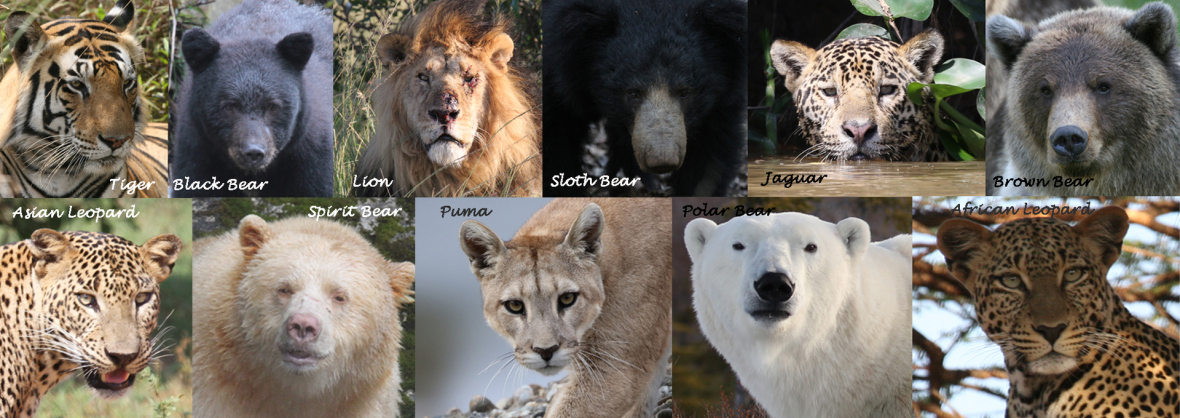

Indian Wildlife - Trip Report - Day 14 - Satpura
Drive 18 - Morning
I still had stomach cramps but I didn’t want to miss another drive so out we went on drive number 18. This time we would be exploring Parsapaani in the buffer zone of the park and sharing our vehicle with our good friends Liz & Malcolm.
Just before breakfast we stopped where there were some cave paintings and we debated walking down to see them… then it was mentioned a sloth bear had been seen coming out of the cave, so not such a great idea after all. Sloth bears can be very dangerous. They will usually attack a person’s head causing horrific injuries. Attacks occur because a bear absorbed in what it is doing is suddenly disturbed, the bear’s usual response to such a surprise is to launch a mock charge, followed by roaring and an upright display and if you are very unlucky an attack. I was good with not going to look for cave paintings!
We stopped for breakfast at a high point looking over the national park. The picnic breakfasts at this lodge were the worst… no eggs or Indian snacks, but we enjoyed the view and the company.
There were several check points within Satpura National Park where you national park guide would need to go and ‘check-in and out’ of the zone. At one of these check points there was a blackbuck fawn. It was wild (not tied up or confined) it had chosen to hang out around the check point because it had been injured by a predator attack and had been nursed back to health by one of the park rangers. It was tame enough to get photos of while on foot, but best not to get too close as it liked to head-butt!
At the Lodge
Back at the lodge we watched wildlife coming and going to the pond next to our room patio. We were surprised to see wild boar wallowing in the mud and they were surprised to see us too!
Drive 19 - Afternoon
In the afternoon we went for our only afternoon drive inside the main zone of the park. Due to other people not feeling well, Alan and I had our vehicle to ourselves, plus Bhanu. We concentrated on looking for sloth bears and stopped for gaur and birds of prey along the way (crested hawk eagle, mottled owl and grey-headed fish-eagle).
We took a comfort break at the elephant spot and as we left it heading towards a waterhole our guide spotted a sloth bear. We had the sighting to ourselves and we stayed back from it trying not to spook it. But it had spotted us and made a dash back across the trail to the cover of the forest. Fortunately it paused a couple of times to look at us before it disappeared.
Our driver took us round to where he thought it might reappear and sure enough it had and crossed the road, this is where Liz, Malcolm, John & Sandra’s vehicle saw it.
The sloth bear walked along a rocky outcrop some distance from the trail before disappearing again. We headed up another level of trail and waited and heard rustling. Here was the bear again! It was just us and we stayed very still, it started to come towards us and looked like it might cross the road when another vehicle came and forced the bear back into cover.
We waited a short while, but as more vehicles arrived it was clear it wasn’t likely to come back out and as the light faded we made the decision to head back to the river crossing point and back to the lodge.
How did sloth bears get their name? 18th-century museum curators were sent specimens of a large furry mammal with long curved claws, they decided to name them "bear-like sloth" because its claws resembled those of South American sloths. Once they realised that the species was actually a tropical bear unrelated to sloths its name had already stuck! This is what Kipling’s Baloo should really look like.
Day 15 - Satpura
Drive 20 - Morning
The alarm didn’t wake me up this morning, I had a rough night, having skipped dinner and gone to bed early. I wasn’t well enough to go out this morning, but I helped get Alan’s gear ready.
Alan started his morning with bull frog spotting in the ornamental pond at the lodge. You could occasionally see them during the day from the window of the lodge with their eyes just above the water’s surface, but if you went outside they would dive back under the water.
This morning’s drive was in the main zone and not long after entering the park they was a call that a porcupine had been seen. It was a bit of sad scene, the poor thing had clearly been attacked and was missing many of its quills. It had nasty injuries to its face (photos of which I have decided not to share) and it was probably just a matter of time before it either died from its injuries or another predator would come along and make it its meal. This was quite an exciting find for the guides and drivers because porcupines are rarely seen during the day.
In between waiting for something to happen to the porcupine Alan saw a pack of wild dogs in the distance and a jungle omelette… oops sorry, I mean owlet.
A palm civet decided to make a brief appearance during the day time, but quickly decided it wasn’t such a great idea and went back into its home to sleep. Interesting fact… Kopi Luwak is a type of coffee made of coffee beans that pass through the digestive system of Asian palm civets (extracted from its poop). It is one of the most expensive types of coffee in the world!
Stopping for a few birds, Black-naped monarch, Indian scops owl and gaur. The endangered gaur are usually dark brown with white 'socks' but in Satpura there are some individuals that, like the spirit bears in Canada's Great Bear Rainforest, have a recessive gene making their colour paler, even ginger like.
At the Lodge
Meanwhile back at the lodge I got up after Alan left and positioned myself outside on our patio along with my camera. We didn’t take the tripod to India, so I had to carefully prop up the mono-pod and pointed it towards the pond in the hope the wild boar would come back and I could video them. What I didn’t expect was a spotted deer to visit. As soon as I saw it I starting recording and stayed very still. The stag came to the pond to drink, I had to stay so very still so as not to spook it. Just as it started to drink the guys came to clean our room, so it raised its head. Unfortunately I had set up the camera for wild boar… more than half the height of the deer! I didn’t want to disturb the deer and waited until it had a drink before I eventually, very carefully, very slowly, grabbed the mono-pod and managed to get its full antlers into the frame before it left.
Alan got back to the lodge just after 10am and sat on the patio with me before we went for some lunch at 1pm.
Drive 21 - Night
I still didn’t feel well enough to head out on the night drive and at 4:15pm Alan went out again in the hope of seeing the sloth bear mother and her two cubs that he had missed on the last night drive.
This time he got lucky and although not in a great position for photography (no clear view of them during the best lighting) he managed to get some photos of them on their mothers back and climbing a tree. He also did some video of them (our regular trip report readers will know Alan and his videoing skills are a source of great comedy moments for me and I’ve tried my best to put together the few frames where Alan kept the camera still for more than a second!) Warning: take your motion sickness tablets before watching the video, lol.
Sloth bears are the only species of bear that carry their young on their back. Their long fur is easy for the cub to grip. It is thought mothers carry their young like this as a precaution against other predators, allowing her to hold off potential attackers while her young are safe behind her. The cubs cling to their mother's back even when she is digging for food or charging a tiger. They rarely change their position, with one cub riding near the neck and the other near the rump and always maintaining those positions. When alarmed the cubs bury themselves in their mother's fur!
Day 16 - Satpura
Drive 22 - Morning
Drive number 22 and the last of our trip, I wasn’t going to miss this one! Across to the main zone, our first sighting was a wild dog surveying its territory.
We stopped to photograph sambar deer and gaur around a waterhole and then continued on to lovely peaceful spot along the river where it ran through a rocky area. We were able to get out of the vehicle and explore the area on foot. This was a previous picnic point, but after a tiger had appear on one of the rocks it was decided it wasn’t quite so suitable. No tigers today, just the wonderful sounds of the jungle birds.
I mentioned to our naturalist (one from the lodge) that neither Alan or I had seen a giant squirrel yet, so the park guide set to looking for one and within 10 minutes had found us a pair that were chasing each other up and down a tree.
We stopped for langur monkey, blue bull, and a few more birds including a serpent eagle, black-rumped flameback woodpecker, savanna nightjar, painted stork and mottled owl.

